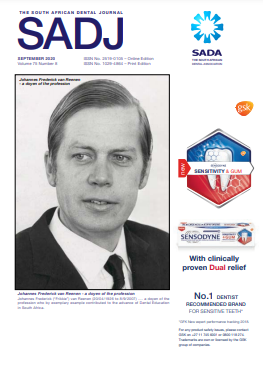Development of a radiographic dental implant guide for identification of dental implant types
DOI:
https://doi.org/10.17159/2519-0105/2020/v75no8a3Keywords:
dental implants, radiographic dental implant guide, implant typesAbstract
INTRODUCTION: Identification of dental implant types can be a complex process for inexperienced health care professionals. Dental implants can have subtle differences in their morphology, which make it difficult to distinguish them from one another The unique appearance of dental anatomy and the placement of custom restorations ensure accurate identification of bodies or human remains when radiographic techniques are correctly applied. AIMS AND OBJECTIVES: To develop a radiographic dental implant guide for ten common dental implant types currently used in the Western Cape, South Africa; using their morphological characteristics observed on pantomographs. DESIGN: The methodology considered for this research study was a positivist approach through a quantitative, exploratory, non-experimental research design. METHODS: Ten commonly used dental implants were radiographed at straight tube (ST), off-centre (OC) and severe off-centre (SOC) angles to create a reference instrument Two reviewers used the morphologies of the different dental implant types, namely the apex, thread and neck, observed on ante-mortem pantomographs, and compared it to the appearance of the dental implants in the reference instrument to make a positive identification match. The straight tube image of all ten dental implant types in the reference instrument was used as the initial point of reference to positively identify the morphological characteristics of each dental implant type on the pantomographs. RESULTS: A total of 380 dental implants could be identified on 105 pantomographs reviewed. Of the 380 dental implants, 350 dental implants (91%) were identified as dental implant types listed in the reference instrument while 30 dental implants were identified as another type of dental implant type not listed in the reference instrument A total of 208 dental implants (54.2%) could be positively identified on the ante-mortem pantomographs using the straight tube images in the reference instrument. The morphological characteristics of the dental implant types were described using x-ray imaging of dental implants. The ten commonly used dental implants types could be positively identified by two independent reviewers and based on this a radiographic dental implant guide was developed. CONCLUSION: Each dental implant type had unique morphological characteristics as well as similarities which enabled distinction between the different dental implant types. The dental implant guide developed could be used by dentistry and radiography students. The dental implant guide may be useful in the field of forensic dentistry and forensic radiology.
Downloads
References
Silva R.F, Franco A, Gratäo de Castro M, Dumont J.A.V, Garcia R.R, Batista de Souza J. Dental Human Identification using Radiographic Records of Oral Implant Placement - a Case Report. Austin Journal of Forensic Science and Criminology. 2014: 1(1): 1-3.
Pretty A, Sweet D. A look at forensic dentistry. British Dental Journal. 2001; 190: 359.
Verma A.K, Kumar S, Rathore S, Pandey A. Role of dental expert in forensic odontology. National Journal of Maxillo-facial Surgery. 2014: 5(1): 2-5.
World Medical Association (WMA). WMA Declaration of Helsinki - Ethical principles for medical research involving human subjects. 2018. https://www.wma.net/policies-post/wma-declaration-of-helsinki-ethical-principles-for-medical-research-involving-human-subjects.
Nuzzolese E, Lusito S, Solarino B, Di Vella G. Radiographic dental implants recognition for geographic evaluation in human identification. Journal of Forensic Odontostomatol.2008: 27: 8-11.
De Angelis D, Cattaneo C. Implant Bone Integration Importance in Forensic Identification. Journal of Forensic Sciences. 2015: 60(2): 505-8.
Berketa J.W, James H, Langlois N.E.I, Richards L.C. A study of osseo-integrated dental implants following cremation. Australian Dental Journal. 2014: 59(2): 149.
Brown R.M, Devenport J.S. Forensic Science: Advanced Investigations. Boston: Cengage Learning. 2012.
Berketa J.W, Hirsch R.S, Higgins D, James H. Radiographic Recognition of Dental Implants as an Aid to Identifying the Deceased. Journal of Forensic Sciences. 2010; b:55(1): 66.
Byraki A, Costea A.V, Curca G.C, Hostiuc S. Morphological analysis of dental implants - forensic significance. Romanian Journal of Legal Medicine. 2010: 18(3): 207-2012.
Dumancic J, Kaic Z, Njemirovskij V, Brkic H, Zecevic D. Dental identification after two mass disasters in Croatia. Croatia Medical Journal. 2001: 42: 657-62.
Soukoulis, S. Forensic odontology and a dental implant registry. 2016. https://www.linkedin.com/pulse/forensic-odon-tology-dental-implant-registry-dr-steven-soukoulis?trk=port-folio_article-card_title.
Michelinakis G, Sharrock A, Barclay C.W. Identification of dental implants through the use of Implant Recognition Software (IRS). International Dental Journal. 2006: 56(4): 203-8.
Berketa J, James H, Marino V. Survival of batch numbers within dental implants following incineration as an aid to identification. Journal of Forensic Odonto-Stomatology. 2010; a:28(1): 1-4.
Downloads
Published
Issue
Section
License
Copyright (c) 2021 Lisa Vermeulen, Aladdin Speelman, Valdiela Daries, Vincent Philips

This work is licensed under a Creative Commons Attribution-NonCommercial 4.0 International License.





.png)